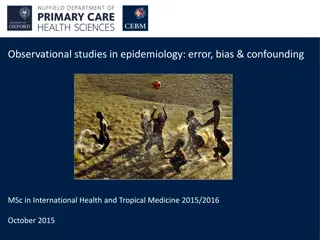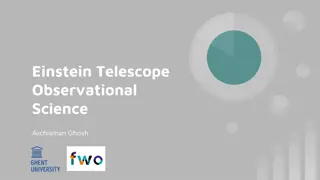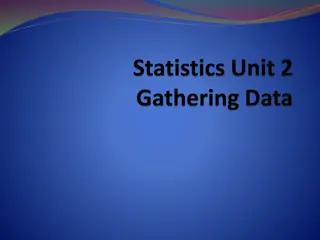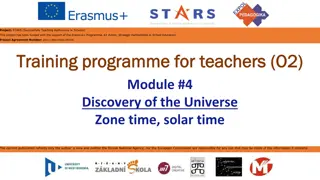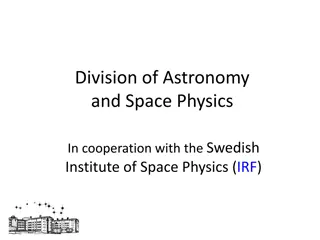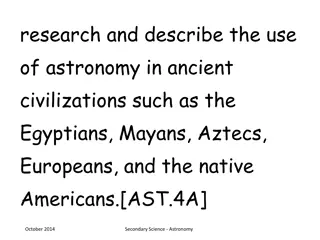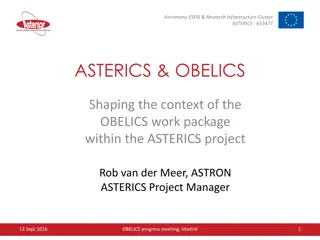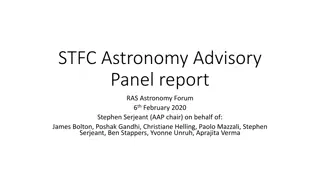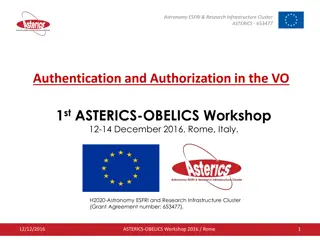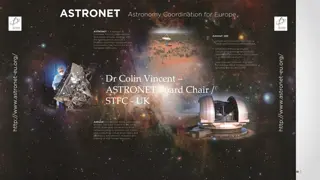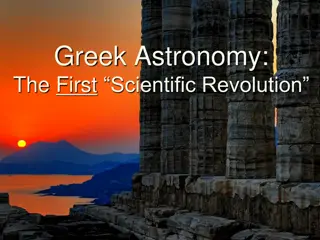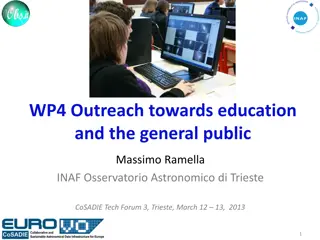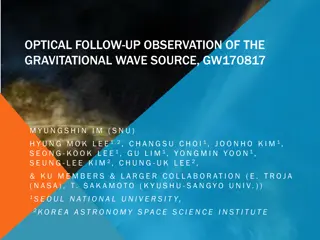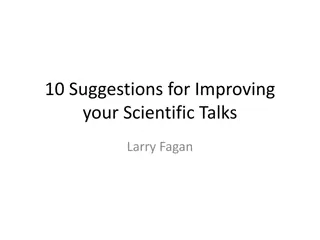Overview of Observational Techniques and Student Talks in Astronomy
This content covers observational techniques, student talks, and dates related to various astronomical topics such as gamma-ray astronomy, basics of gamma-ray interaction, scintillators and solid-state detectors, Compton telescopes, and pair telescopes. It provides insights into the main processes involved in gamma-ray interactions and the equipment used in detecting and measuring high-energy particles. The student talks schedule includes presentations on diverse subjects like mm/submm astronomy, polarization, neutrinos, X-ray basics, and future radio astronomy.
Download Presentation

Please find below an Image/Link to download the presentation.
The content on the website is provided AS IS for your information and personal use only. It may not be sold, licensed, or shared on other websites without obtaining consent from the author. Download presentation by click this link. If you encounter any issues during the download, it is possible that the publisher has removed the file from their server.
E N D
Presentation Transcript
Observational techniques meeting #11
Student talks and dates: May 9: Liantong Luo (mm/submm) May 14: Gidi Yoffe (High-res spec); Dotan Shaniv (JWST) May 16: Yigal Sternklar (Polarization); Oran Ayalon (CMB#1) May 21: Andra Tesi (Neutrinos); Amir Rosenblatt (X-ray basic) May 23 no class May 28: Simon Mahler (SZ effect); Noam Morali (IFU) May 30: Yuval Rosenberg (UV); Noam Segev (GAIA) June 4: Abhay Nayak (Euclid); Tom Koren (light echoes) June 6 no class June 11: Gidi Alon (future radio); Lior Gazit (LIGO) June 13: Tal Levinson (TeV); Gilad Sade (?) June 18: Mehran Shehade (CR); Yuval Tamir (Robotics) June 20: Asaf Miron (CMB #2 - polarization); Aviram Uri (LISA) June 25: Tom Manovitz (MIR/FIR); Mark Aprestein (X-Ray Polarimetry) June 27: Dan Levy (nano-satellites); Or Hadas (?), Exoplanet missions (Dror Berechya
Basics: -ray interaction Main processes: Photoelectric effect dominant below 1 MeV Compton scattering 1-5 MeV Pair production dominant above ~5 Mev
Scintillators/solid state detectors Scintillators: Materials (e.g., NaI, CsI) which emit photons when hit by high- energy charged particles NM9 1.gif NM9 3.gif Scintillators need to be coupled to light detectors (e.g., photomultipliers). Some semiconductors (Ge, CdTe, CdZnTe) can act as both scintillator and light detector
Compton telescopes Rely on two-stage detection (scattered and absorbed photon) Detection points and measurements of electron and photon energies provide a direction up to a circle on the sky More than 1 photon required for localization
Pair telescopes Combine layers of converter material (metals such as lead) that convert photons to pairs, with detector layers that determine direction and energy of resulting electron/positron pairs. Detector layers used to be spark chambers, now replaced with silicon- strip detectors. At bottom, you often install a calorimeter (detector that absorbs the particles and measures total energy) Anti-coincidence shields are a must
Imaging in gamma-rays focussing not practical Larger detectors more signal, but also more noise; poor directionality options: collimator + pixels (low efficiency), hard for high energies Shielding/occultations (rough, low efficiency) Coded mask
Major recent missions: CGRO NASA great Observatory Operational 1991-2000 30 KeV 30 Gev, order of magnitude better than previous Main instruments: BATSE (burst detector, 20-1000 KeV; NaI); OSSE (scintillator spectrometer, 0.05-10 MeV; 8% resolution); Comptel (compton telescope, 0.8-30 MeV); EGRET (pair telescope, 30 MeV 10 GeV)
Major recent missions: Integral ESA mission Operational 2002-now Main instruments: SPI (Ge spectrometer, coded mask), IBIS/ISGRI (scintillator/solid state imager, coded mask, 15 KeV- 10MeV)
Major recent missions: Swift NASA midex mission Operational 2004-now BAT: burst alert telescope (20- 150 KeV, coded mask, CZT detectors) Image of a technician inspecting the Swift coded aperture mask.
Major recent missions: Fermi NASA mission Operational 2008-now LAT pair telescope with silicon strip detectors + calorimeteres, largest, most sensitive up to 30 GeV GBM: burst monitor (NaI scintillator 10 KeV- 1 MeV + BGO (Bismuth Germanate; 150 KeV 30 MeV)
Discovery: Vela Cs I scintillators, nuclear ban treaty enforcement; 1967-1973
Source Galactic vs extragalactic: settled by CGRO/BATSE
How long can a short GRB be? GRB 060614 was a long GRB (100s), with no SN, and probably not associated with massive stars similar to other long events (Gal-Yam et al.; Fynbo et al.; Della Valle et al.; Gehrels et al. 2006, Nature 444) Also, GRB 060605 ? (e.g., Ofek et al., Thoene et al.) XRF 040701 ? There may well be more than one group of short GRBs


![❤[PDF]⚡ Civil War Talks: Further Reminiscences of George S. Bernard and His Fel](/thumb/20551/pdf-civil-war-talks-further-reminiscences-of-george-s-bernard-and-his-fel.jpg)
